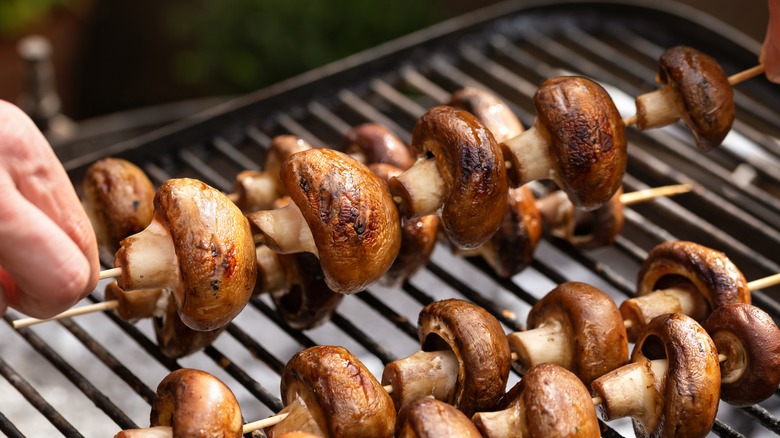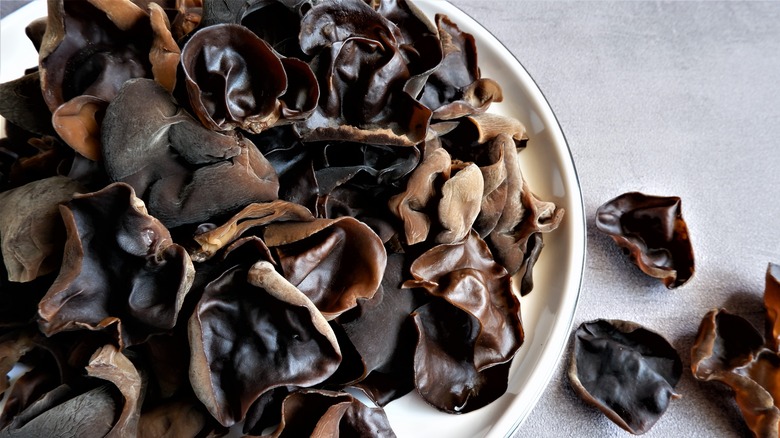The Science Behind Why It's Almost Impossible To Overcook Mushrooms
When we think of food that is impossible to ruin or can be easily made by kids, we often default to egg dishes: hard-boiled eggs for sandwiches, scrambled eggs, or maybe even omelets with a few trimmings. But there's also another ingredient that is almost impossible to overcook and comes in over 10 varieties. Some people refer to its taste and texture as 'meaty' so it's often used in vegetarian dishes.
Behold, the mushroom. Mushrooms are often sold in the fresh produce section of a grocery store but they are neither plant nor animal produce. They are fungi, but there's a lot we don't know about mushrooms and their ecology yet. What we do know is that the different types of mushrooms — be they shiitake, button, or oyster — are versatile, flavorful, and forgiving to newbie cooks.
One of the fascinating aspects of cooking mushrooms is their ability to withstand heat and retain their structural integrity even when cooked for extended periods. While it is possible to burn mushrooms through sheer negligence, it's difficult to overcook mushrooms for two main reasons. First, the cellular makeup contains chitin, a compound found in the cell walls that enables them to withstand high temperatures. Second, mushrooms have a high water content which acts as a heat barrier.
Chitin is what helps mushrooms stay tender
In 2016, America's Test Kitchen ran an experiment to test what heat does to mushrooms, zucchini, and beef tenderloin by steaming the food and recording its "bite." After 40 minutes, the mushroom stayed tender, the zucchini turned to mush, and the beef became leathery.
The mushroom emerged the winner thanks to chitin. Chitin is a complex carbohydrate that's found in the cell walls of fungi, exoskeletons of most insects, and beaks of cephalopods (e.g. squid). This compound allows the mushrooms to stand up to temperatures up to 716 degrees Fahrenheit and helps them maintain their shape even when exposed to high temperatures.
As PBS notes, this is different from the molecular structure of meat and plants. The protein in meat is squishy and malleable when it's raw. But prolonged heat pushes out moisture and creates empty spaces for the protein to contract until it becomes tough and chewy. As for vegetables, the hemicellulose and pectin that hold plant cell walls together break down after exposure to heat.
Mushroom's high water content gives it a heat barrier
Mushrooms are not the only vegetable with high water content. Tomatoes and spinach are among the vegetables with high water content too, which is why when you roast or sauté them, they shrivel up considerably. Mushrooms are no different; in fact they are 80-90% water. This characteristic plays a significant role in their ability to withstand prolonged cooking. As mushrooms are exposed to heat, the moisture within them begins to evaporate. The water content acts as a protective barrier, preventing the mushrooms from drying out too quickly.
What this means is you should cook more mushrooms than you think because they will reduce considerably. Also, when sautéing mushrooms, the water content will seep out into the pan so remember to cook off all the liquid before removing them from the heat. Else, the mushrooms will be soggy rather than nicely browned.
While it's not entirely impossible to overcook mushrooms, it would require extreme circumstances or deliberate mishandling. This makes mushrooms a forgiving ingredient in the kitchen, so kids, home cooks, and chefs alike can experiment with various cooking techniques without the fear of ruining the dish.


